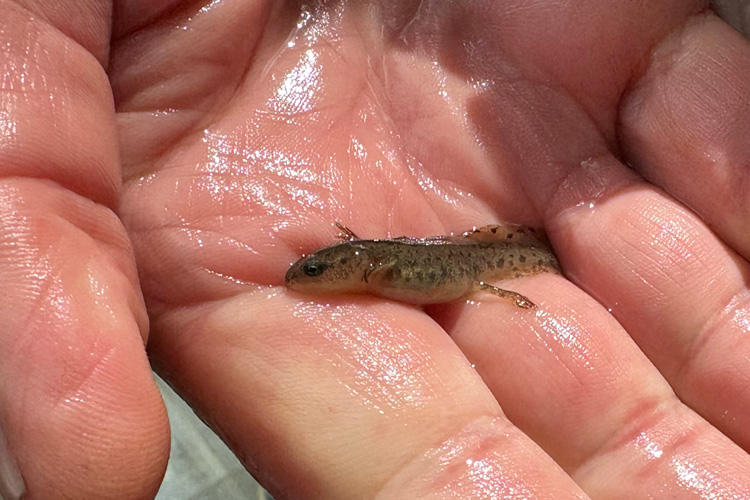Newts take the stage during annual mating ritual at UC Botanical Garden
Every year, the Japanese Pool hosts a bevy of California newts intent on mating, laying eggs and then going their own way
April 4, 2023

California newts are adorable, but people should avoid picking them up. Their skin is toxic — an effective deterrent to predators, including humans. (UC Berkeley photo by Marissa Gutierrez)
Spring sparks the amorous activities of the California newt, and the UC Botanical Garden is a great place to check out the annual mating rituals of one of the state’s iconic salamanders.
Each year, male newts stake out the Japanese Pool — a gift from the Japanese government after the close of the 1939 Golden Gate Exhibition on Treasure Island — and wait for females to amble in from the surrounding garden. Their flirtations culminate in a lengthy duet, called amplexus, during which the male clasps the female from behind and rubs his chin on her nose to stimulate her to lay eggs.
If you’re lucky, you may see a pair of mating newts, male clasping female, placidly floating along the bottom of the pool. Males are bulkier and have flatter tails than females, likely an adaptation to spending much more time in the water in anticipation of encountering females.
The male then scatters small packets of sperm along the bottom of the pond, followed by the female, which hoovers them up into her cloaca, where they fertilize her eggs. She later lays the eggs in a jellylike mass on a submerged leaf or twig, where they await hatching later in the spring. Larvae, like miniature newts but with gills to breathe underwater, spend several months to a year in the pool before disappearing into the woods, where they live a solitary existence and, after they mature, are regular visitors to the pool. They can live 20 years or more.
The garden hosts two species of newt — the rough-skinned newt (Taricha granulosa) and California newt (Taricha torosa), which has a more reddish back and more of a yellow-orange belly. The newts grow to 6 inches in length. According to retired UC Botanical Garden Director Paul Licht, a Berkeley professor emeritus of integrative biology, both species have toxic skin that ensures they have few predators.

Paul Licht, former director of the UC Botanical Garden, holds a newt larva. After hatching and spending up to a year in the pond, it will lose its gills and migrate out of the pond to mature in the surrounding gardens. In three to five years, if all goes well, it will return to mate in the pond. (UC Berkeley photo by Marissa Gutierrez)
The UC Botanical Garden is open daily from 10 a.m. until 5 p.m. (except for the first and third Tuesdays of the month), and admission is free for UC Berkeley faculty, staff and students, as well as staff from Berkeley Lab and the UC Office of the President.
The garden’s director of collections, Andrew Doran, noted that the Japanese Pool will be drained later this year so that the bottom can be repaired. It’s not a natural pond, and its cement bottom is leaking after 80 years of wear and tear. The garden staff plans to relocate as many of the newts as possible to other ponds, Licht said, which will disrupt the newt community for a while. But he added that he fully expects these resilient amphibians to return next spring. After all, they’ve been here far longer that the garden and the university.

The Japanese Pool was originally on display at the 1939 Golden Gate Exposition on Treasure Island and subsequently was donated to the UC Botanical Garden by the Japanese government. This summer it will be drained and the bottom repaired. (UC Berkeley photo by Marissa Gutierrrez)